UK VacuForm machine - Cheap 1200W Aldi heater conversion tutorial
Vacuform machine using 2x £14.99 1200W Aldi heaters
Tools and materials required:
2x Aldi 1200W heaters @£14.99 each
Screwdriver, pozi no.2
Small flat head screwdriver (approx 2.5mm?)
Wire strippers or sharp knife (Stanley or scalpel)
Wire cutters
Crimpers
6x female crimp terminals to fit on 5mm wide male flat terminals
6-8mm heat shrink sleeving or alternative insulating sleeve
4mm heatshrink or other suitable sleeving
Heat gun (if using heat shrink)
Soldering iron
Solder (and preferably liquid flux or flux jelly)
Hi folks,
I was in Aldi today and saw these 1200W heaters on offer for £14.99 each. I opened one of the boxes up and figured that the heating area looked about the size of an A4 sheet of paper.
Inspired by @Fon Davis excellent SWSCA course, http://forums.stanwinstonschool.com/post/url=https://www.stanwinstonschool.com/tutorials/making-a-sci-fi-helmet-vacuum-forming-machine , I figured that two of these side by side would be perfect to make a vacuform machine suitable for an A3 sheet of the vacuum forming material of your choice. So I bought two!

I'm afraid this is probably only going to be of use to UK folks, unless these particular heaters are readily available elsewhere.
This isn't a full vacuform machine build but rather just the electrical side. I want to upload this quickly while these heaters are still available at such a good price.
Anyway, I got home, opened them up and lo and behold, they're almost exactly A4 size.

(By the way, sorry about the crappy lighting. I still need to sort out some decent lighting in my new mancave that I finished this weekend
And I don't have time to optimise all the photos because, as I mentioned, these heaters might not be available for long. If I remember, I'll try to fix them after this post is up.)
I'm not sure how suitable the power rating is, but I'm sure it'll be enough. The worry is that it's too much, in which case it may be possible to adjust the power by means of a (additional) thermostat. More on that later.
Right, down to the nitty gritty.
Unpackage everything.
This won't be valid in 30 seconds, so toss it in the bin.

Remove the six thousand screws holding the numerous pieces of casing together. They all came out really easily.

On the right, there is the base of the unit containing an oscillating motor. I haven't tested this but it looks like it probably slowly oscillates about 20 degrees.
There is also a push-to-make momentary switch which is used for a tilt sensor, so if the heater falls out of the base, you don't set your house on fire.
All of this will be discarded.
On the left, there is a bank of 4 rocker switches. Three of those are for switching the individual heating elements on or off. The fourth is to enable the oscillating motor.
These will also be discarded.
DO NOT recycle these switches to switch power to all of the heating elements at once. Each element is 400W and has its own individual switch. 6 of those is 2.4kW. I highly doubt the included switches are rated anywhere near that, so to use them would be dangerous and they will likely melt.
On the side of the heater unit with the connectors to which the switches are wired, remove all of the crimp connectors. Be careful not to put so much stress on the connectors as to damage the heating elements when doing this. The crimps will be discarded anyway, so if necessary just peel them open using some description of pointy-nosed pliers.

Cut the long red wire which traverses the length of the heating unit at the far right side of the photo where it connects to the switch and slide it out of the longer section of woven heat-proof sleeving, also on the right hand side.
Hidden in that sleeve, you will find a thermostat which is rated for 126 degrees celsius (~260 degrees fahrenheit).
This measures the temperature of the thin steel enclosure of the heating unit and creates an open circuit once the temperature exceeds the rated value of ~126'C.
Do not discard this.
As you can see, everything on the right hand side of the photo is disconnected. The switch bank can now be thrown into your random crap box.

Cut the red wire at the left side of the above photo where it joins the nipple shaped terminal and flip it so that the thermostat is on the left hand side.
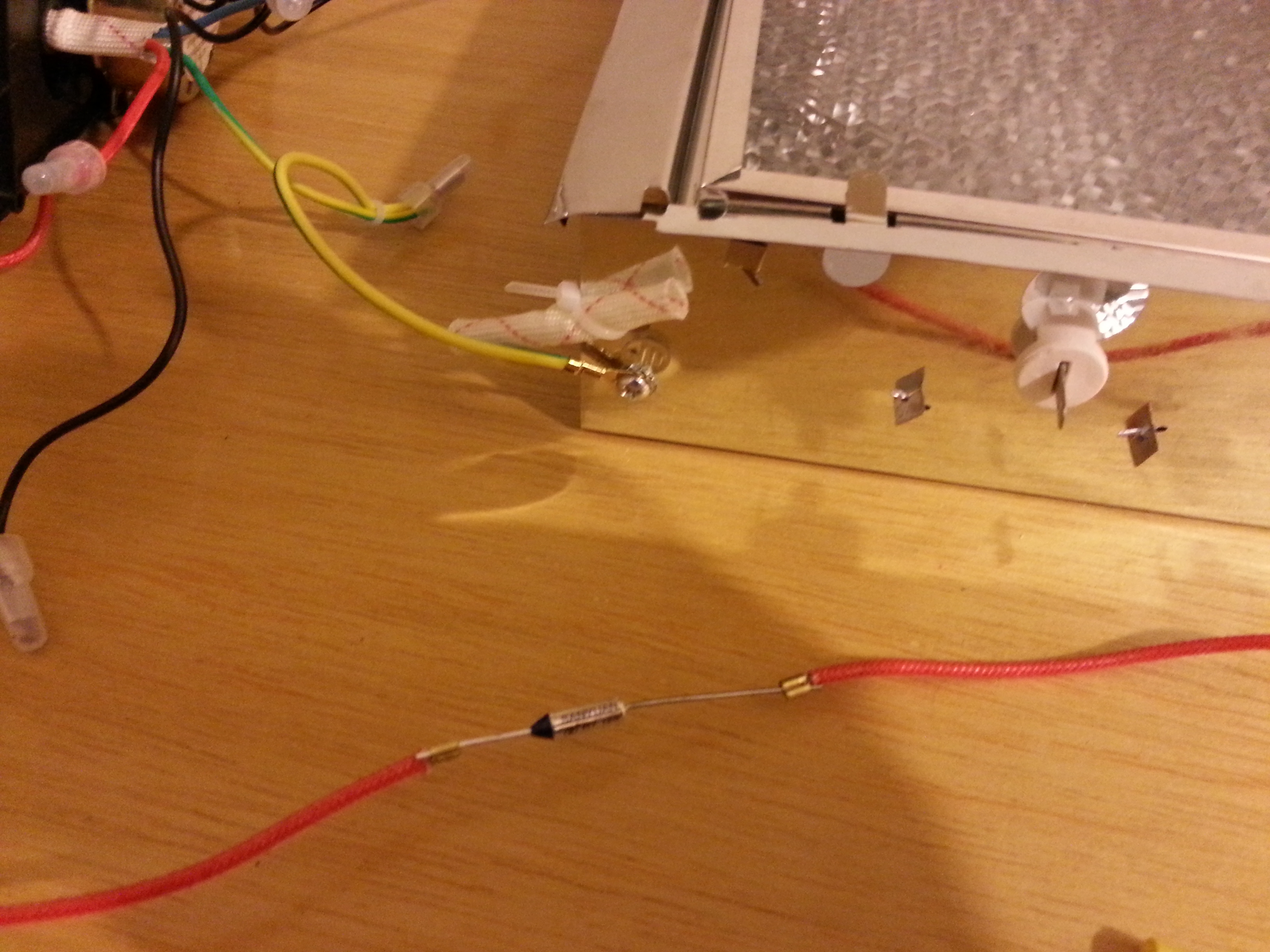
Let's take a look inside that round black container on the left hand side to see what's in it. Annoyingly, it has three-pronged security screws. I found that they could easily be removed using a narrow bladed flat-head screwdriver (approx 2.5mm wide).
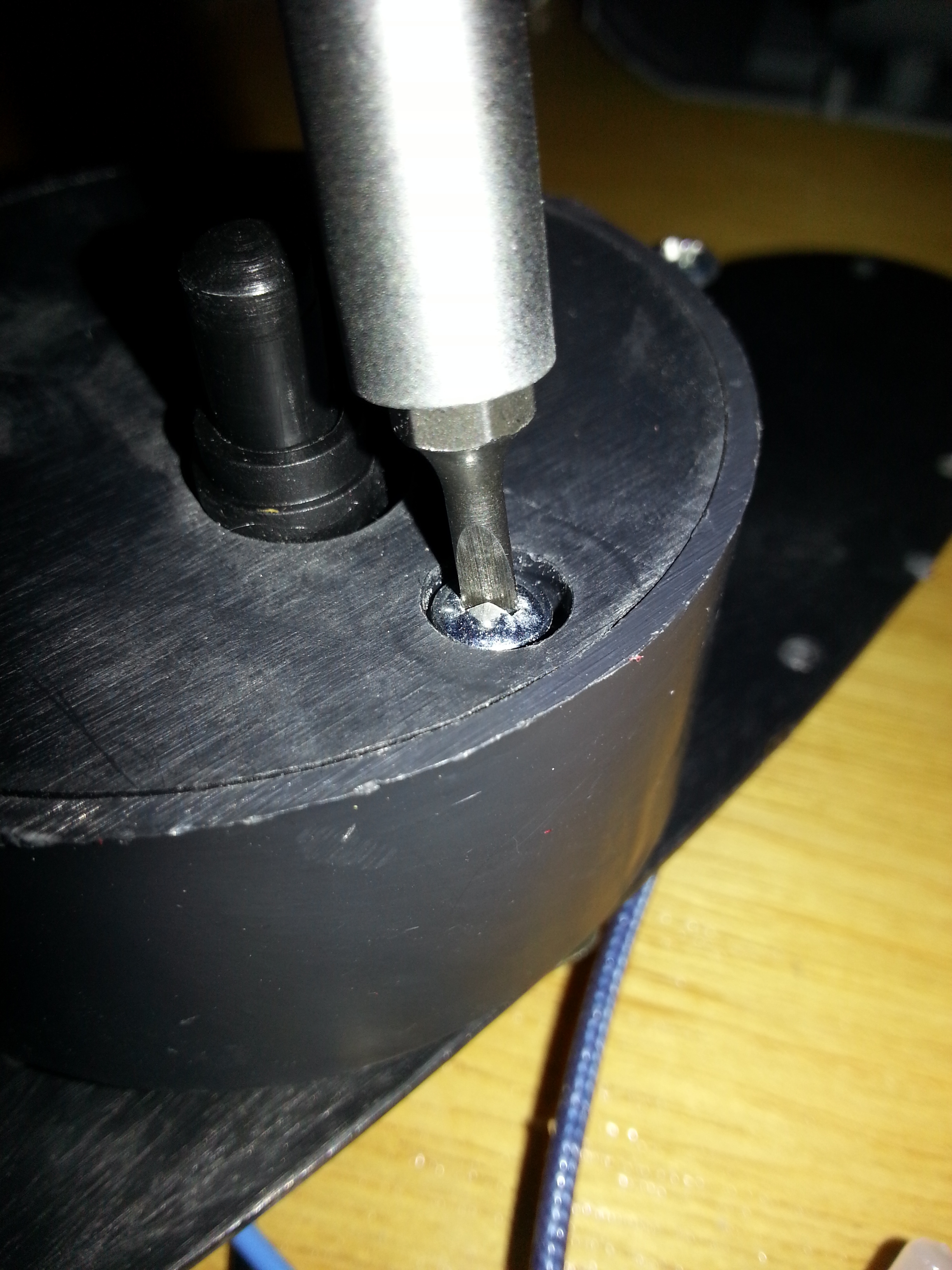
Looking inside, there is nothing of value here.
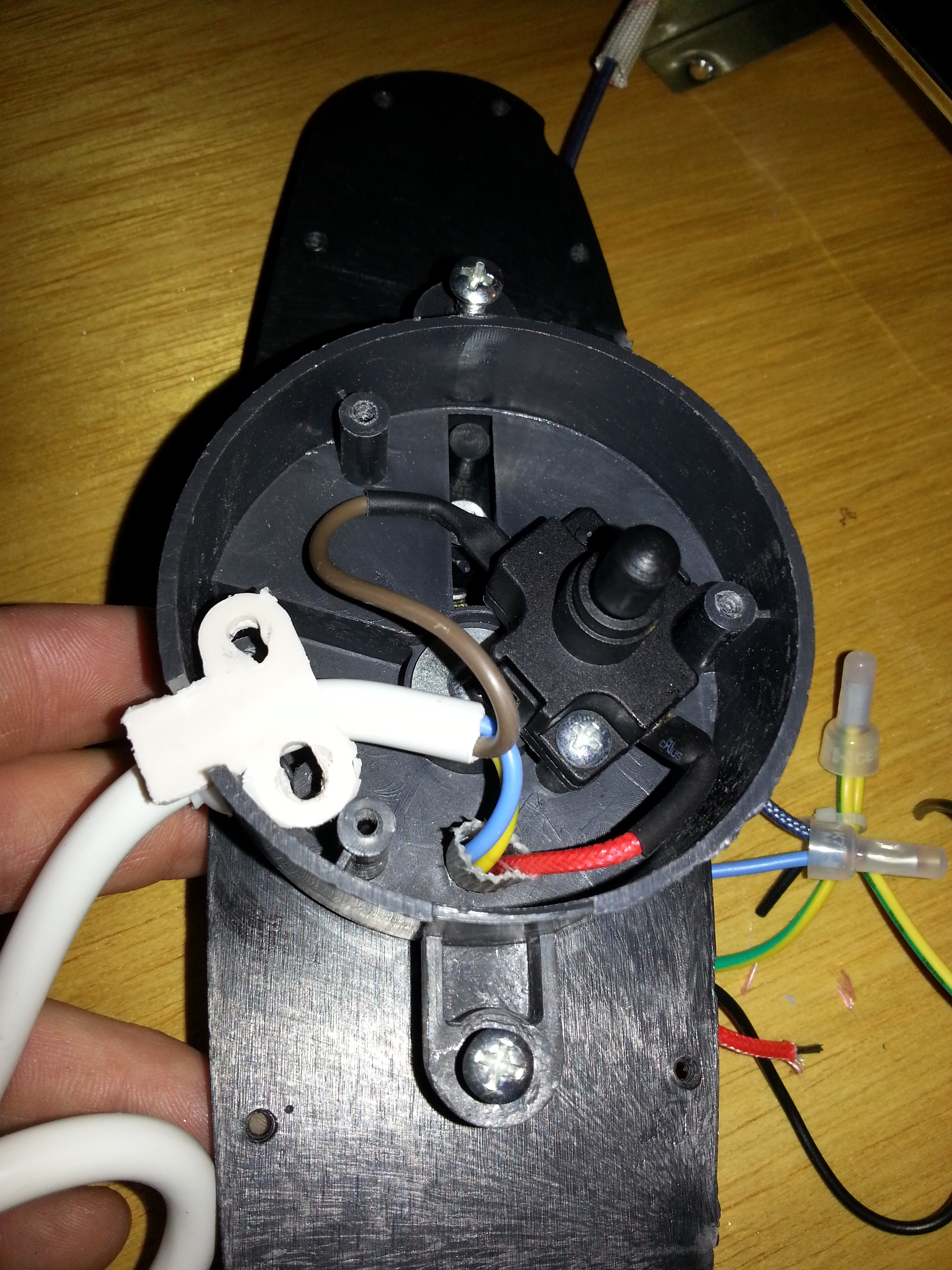
So, cut all of that crap off, leaving as much wire as possible leading to the heating unit.
You should now have just three wires going to the heating unit. Blue (neutral), red (live) and earth (green/yellow striped).
Also, remove the shorter woven heat-proof sleeving from the cable tie on the left, and slide the longer section from the right-hand side into the cable tie. We will tuck the thermostat in here later.
Now take your long red wire with the thermostat (short section of wire now to the left) and position it such that the thermostat will sit evenly in the middle of the long wocven heat-proof sleeve. Then, allowing a bend in the wire, cut it to length so that it reaches the first heating element terminal.

Now take three of your six crimp terminals and cut the red wire into sections to join the three heating elements together, allowing enough slack to fit some heat-shrink sleeving over the female crimps, strip the ends of the wires (a knife works best for this as it is a woven sheath) and crimp the wires as shown below. The crimp terminals have two clamping sections. The smaller part should clamp the bare wire and the larger part should clamp the insulation.

Slip some heat-shrink sleeving over the crimps and fit the crimps to the heating elements. Take extra care to ensure that they are a tight fit. Slide them on and carefully squeeze them closed using the cutter section of a pair of pliers if necessary (don't squeeze too hard!)
Then slip the heat-shrink sleeving oiver the crimps and blast them with a heat gun until they are tightly shrunk.

Now slip the thermostat through the long woven heat-proof cable and take the mains flex cable that was connected into the round black container, trim and strip the ends of the insulation and tin them with your soldering iron. Also tin the three wires coming from the heating unit (blue, red and green/yellow).
Don't forget to slip some heat-shrink sleeving over one set of wires and then solder the mains flex to the heating unit.
Brown (live) goes to red.
Blue (Neutral) goes to blue.
Green/yellow (Earth) goes to green/yellow.
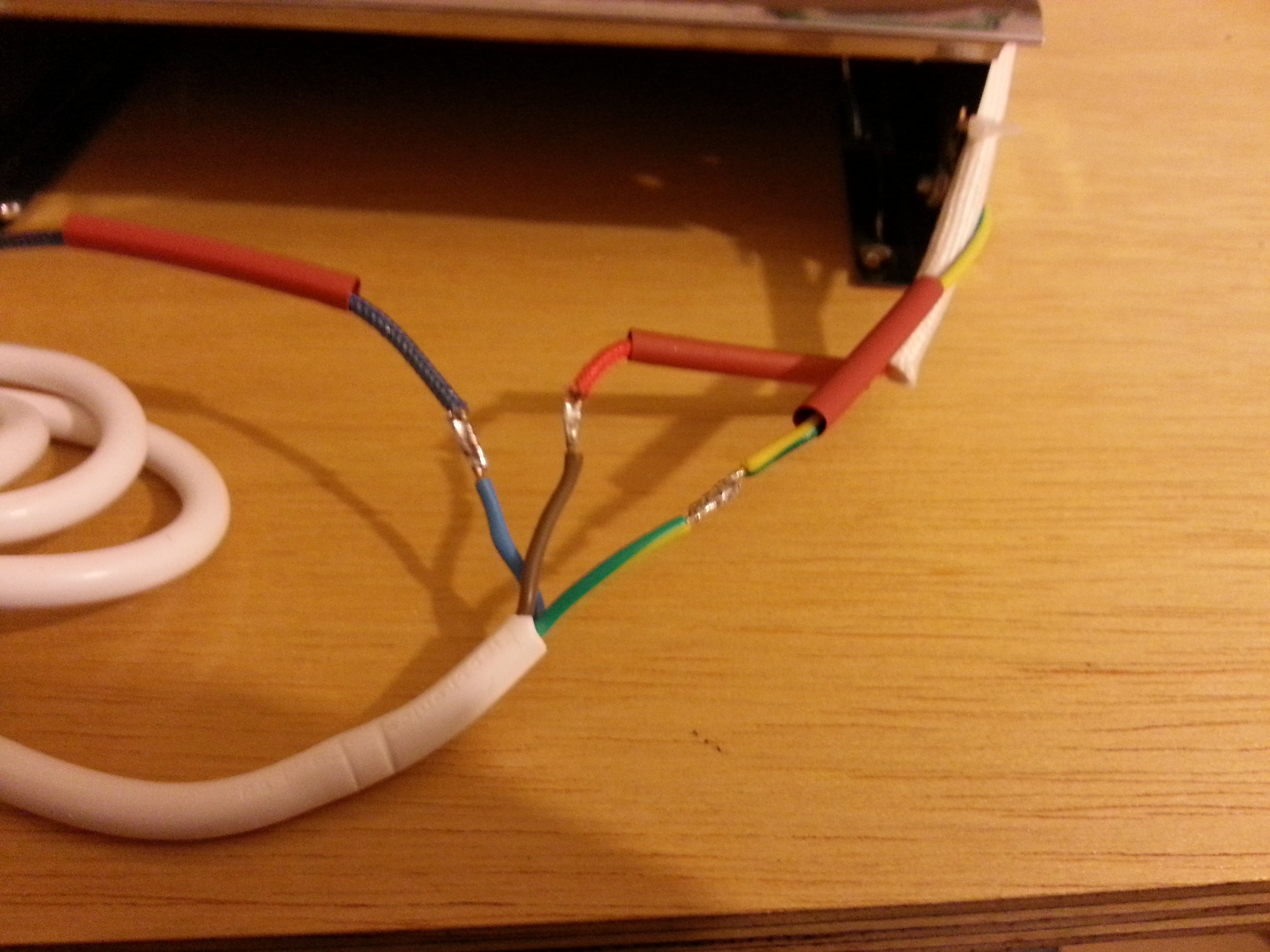
Now slip the heat-shrink sleeving over the bare wire and blast them with your heat gun.

You should now have something looking like this:
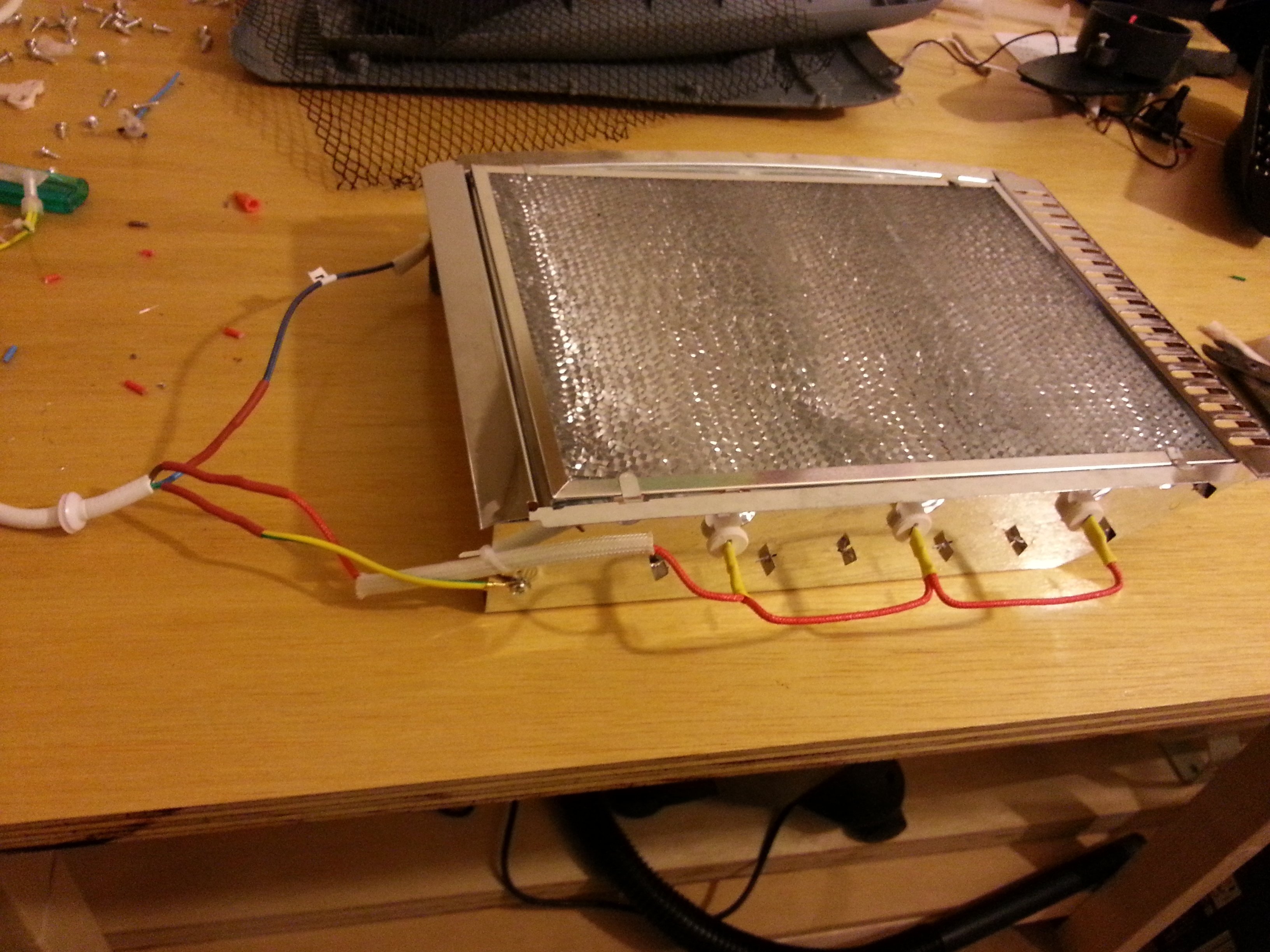
And the other side, which we've not modified.
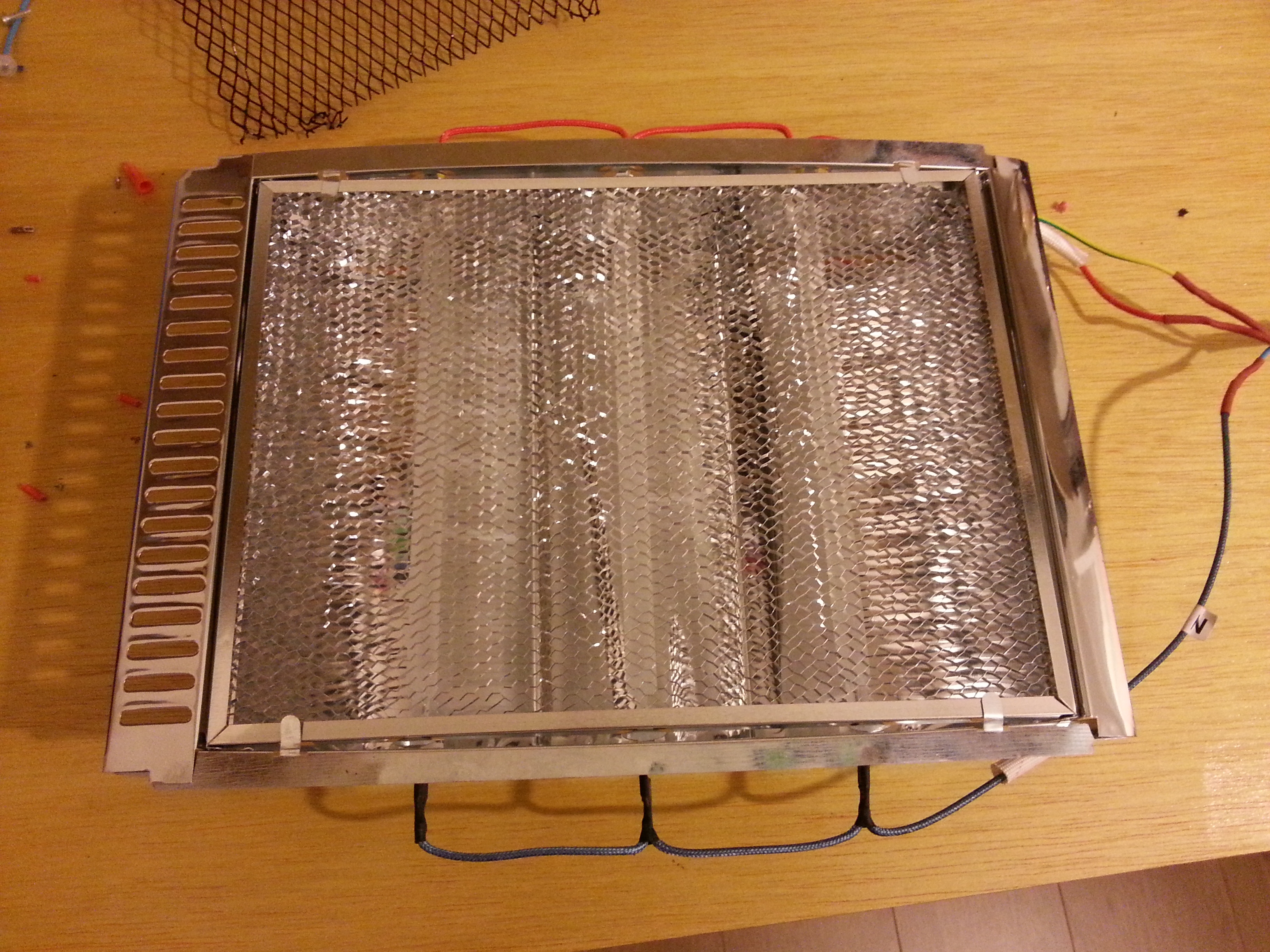
Now ensure the heating unit is sat on a safe surface, all wires are insulated, nothing dangerous is near the heater, cross your fingers and plug it in!

Ta-da!
Now just do this with the second heater and you're ready to fit them into your vacuform frame. For information about building the rest of the machine, take a look at Fon Davis' video linked at the start of this post.
To butt the two heaters a bit closer together, CAREFULLY bend the crimps on the other side of the heater.
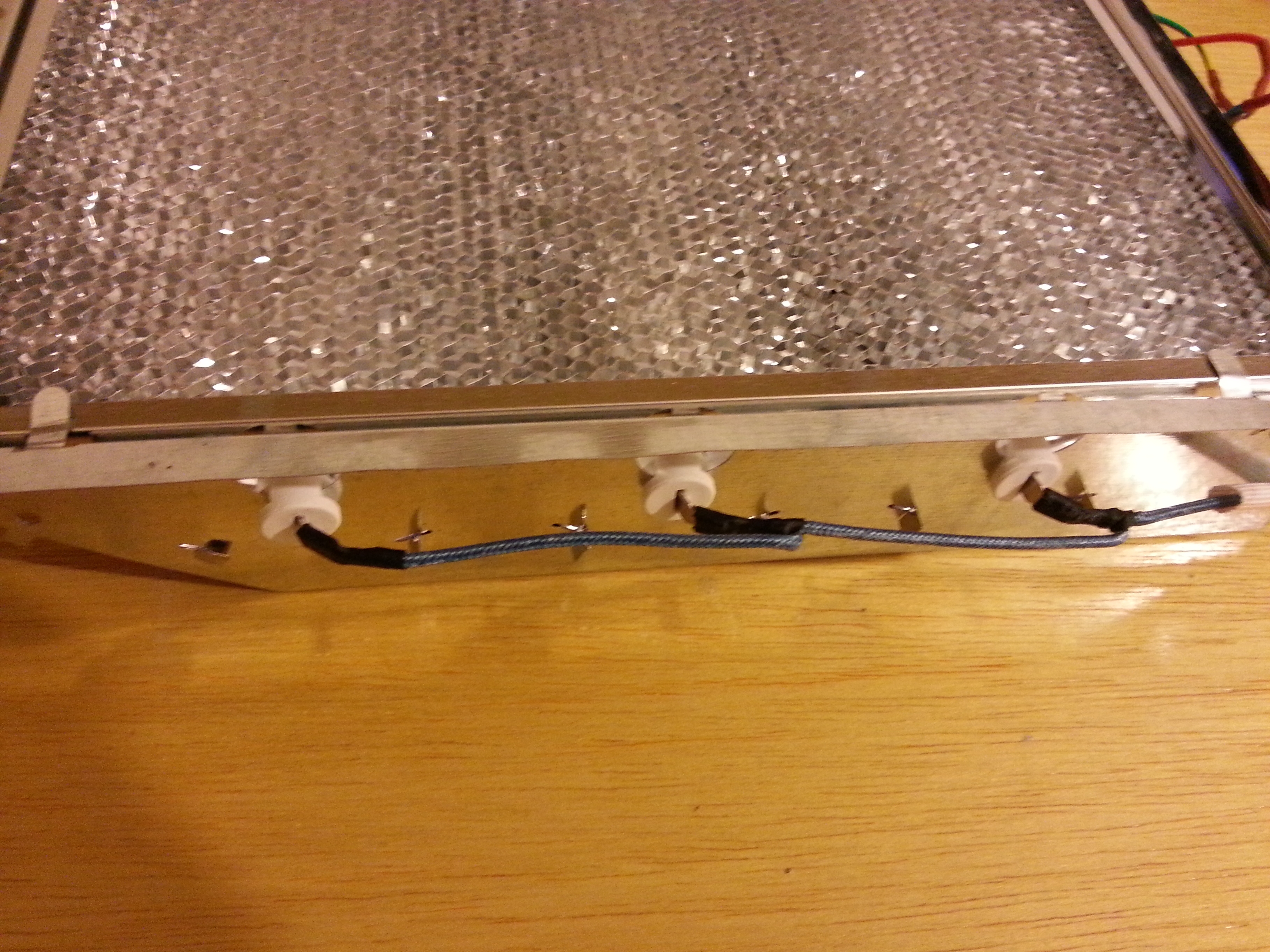
Here's a shot of the underside of the heating unit, showing the back of the heat reflector.

Bonus:
You can optionally scavenge a few useful parts from the leftovers.
Switch bank (again, DO NOT use this to switch power to all of the heating elements at once)

Oscillating(?) motor, could be used for some sort of lightweight halloween prop
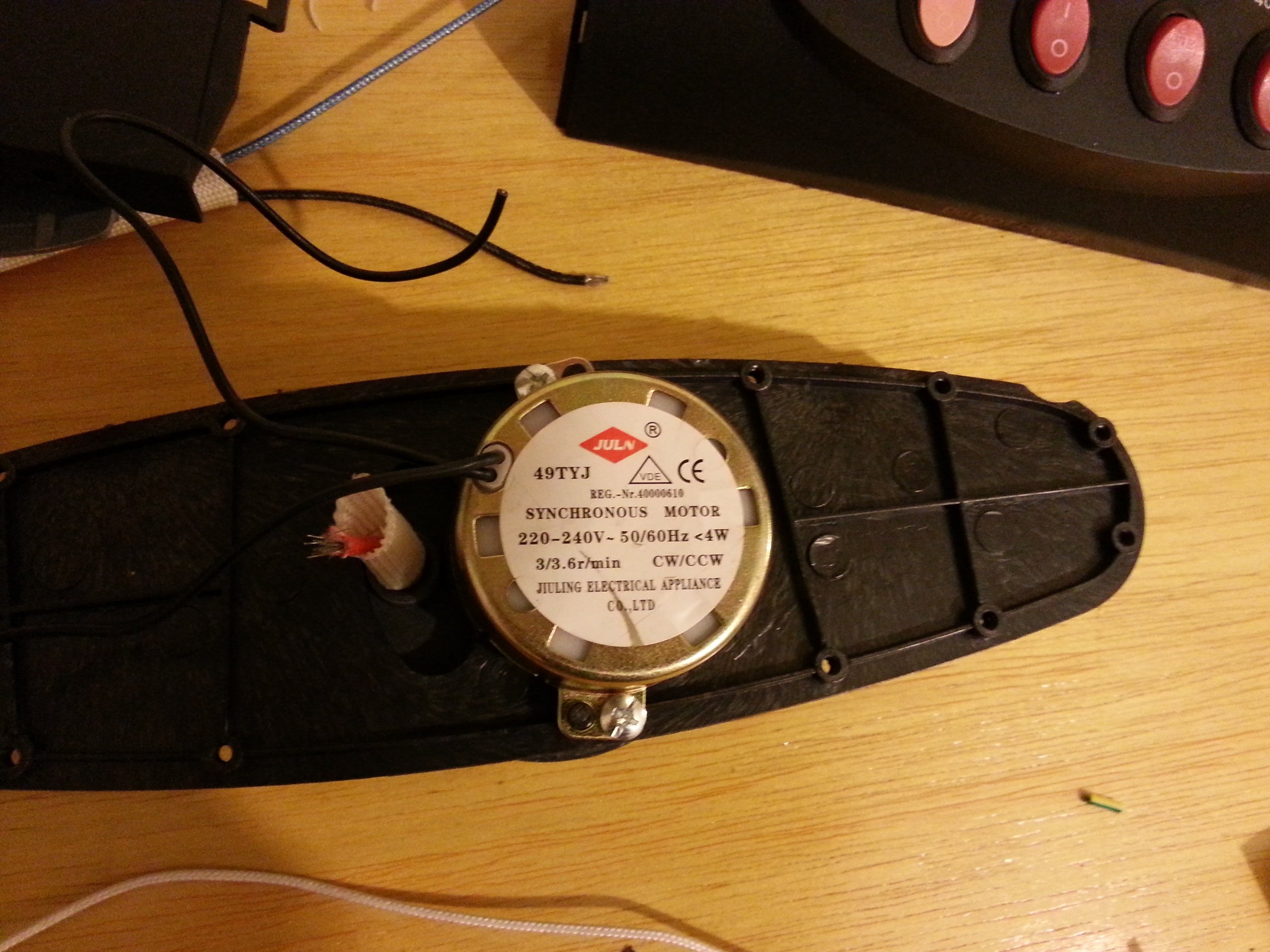
Push-to-make switch, could be used for anything you can think of
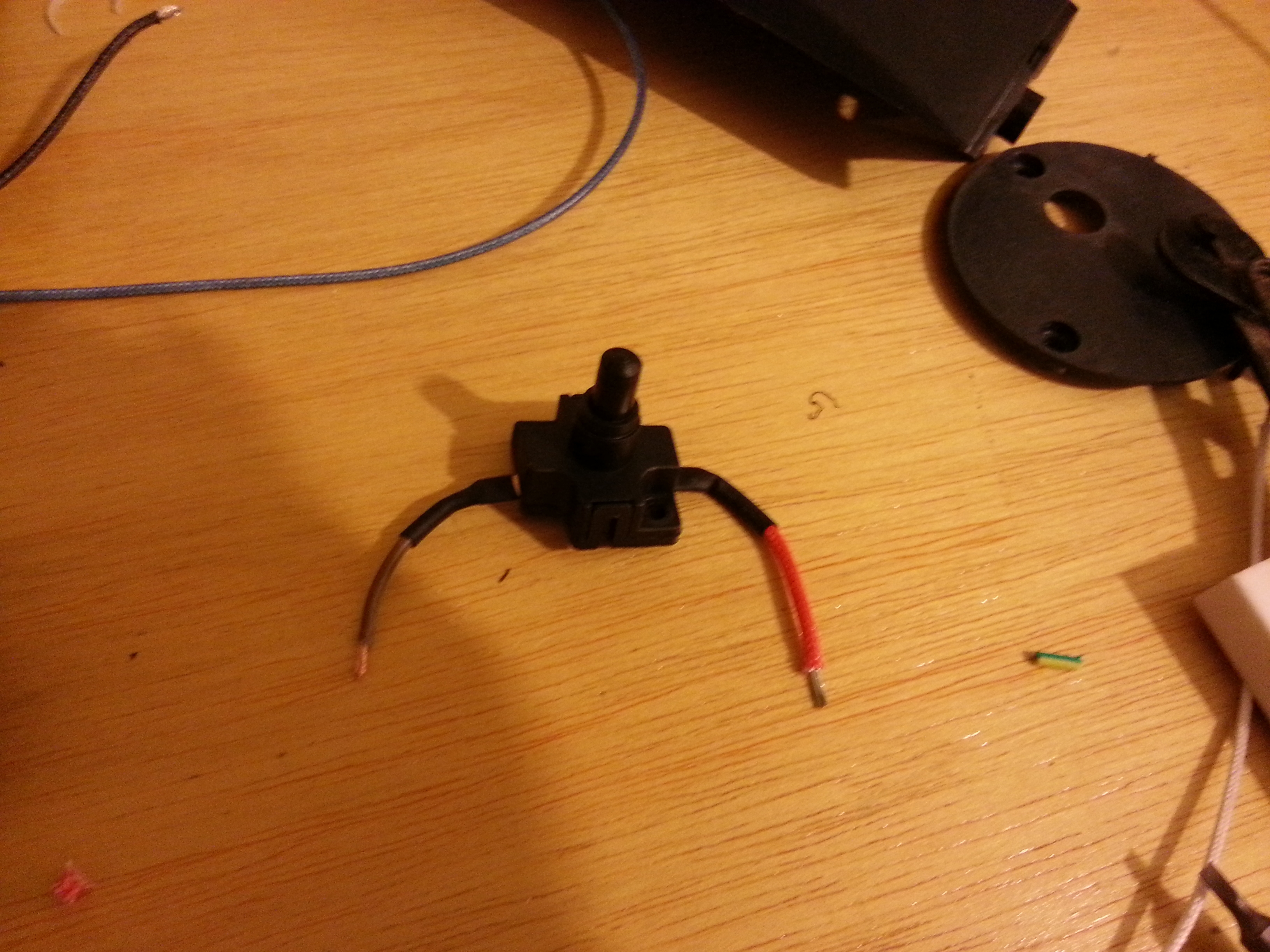
Notes and thoughts:
Retrospectively, I don't know how wise an idea it was to use heatshrink sleeving. I'm not actually sure what happens to it with long term exposure to extreme heat. If anyone has experience here, please chip in.
Hopefully someone finds this useful. It took me about an hour and a half to do this first heater conversion. Much of that was spent looking for crimps and figuring out what to do. I reckon the second one will take less than an hour. It's a very simple heater.
Good luck and have fun!
It's 1:30am here now and I need sleep for work tomorrow, so if there's any questions I'll try to answer them tomorrow!
Cheers,
Stu
Tools and materials required:
2x Aldi 1200W heaters @£14.99 each
Screwdriver, pozi no.2
Small flat head screwdriver (approx 2.5mm?)
Wire strippers or sharp knife (Stanley or scalpel)
Wire cutters
Crimpers
6x female crimp terminals to fit on 5mm wide male flat terminals
6-8mm heat shrink sleeving or alternative insulating sleeve
4mm heatshrink or other suitable sleeving
Heat gun (if using heat shrink)
Soldering iron
Solder (and preferably liquid flux or flux jelly)
Hi folks,
I was in Aldi today and saw these 1200W heaters on offer for £14.99 each. I opened one of the boxes up and figured that the heating area looked about the size of an A4 sheet of paper.
Inspired by @Fon Davis excellent SWSCA course, http://forums.stanwinstonschool.com/post/url=https://www.stanwinstonschool.com/tutorials/making-a-sci-fi-helmet-vacuum-forming-machine , I figured that two of these side by side would be perfect to make a vacuform machine suitable for an A3 sheet of the vacuum forming material of your choice. So I bought two!

I'm afraid this is probably only going to be of use to UK folks, unless these particular heaters are readily available elsewhere.
This isn't a full vacuform machine build but rather just the electrical side. I want to upload this quickly while these heaters are still available at such a good price.
Anyway, I got home, opened them up and lo and behold, they're almost exactly A4 size.

(By the way, sorry about the crappy lighting. I still need to sort out some decent lighting in my new mancave that I finished this weekend
And I don't have time to optimise all the photos because, as I mentioned, these heaters might not be available for long. If I remember, I'll try to fix them after this post is up.)
I'm not sure how suitable the power rating is, but I'm sure it'll be enough. The worry is that it's too much, in which case it may be possible to adjust the power by means of a (additional) thermostat. More on that later.
Right, down to the nitty gritty.
Unpackage everything.
This won't be valid in 30 seconds, so toss it in the bin.

Remove the six thousand screws holding the numerous pieces of casing together. They all came out really easily.

On the right, there is the base of the unit containing an oscillating motor. I haven't tested this but it looks like it probably slowly oscillates about 20 degrees.
There is also a push-to-make momentary switch which is used for a tilt sensor, so if the heater falls out of the base, you don't set your house on fire.
All of this will be discarded.
On the left, there is a bank of 4 rocker switches. Three of those are for switching the individual heating elements on or off. The fourth is to enable the oscillating motor.
These will also be discarded.
DO NOT recycle these switches to switch power to all of the heating elements at once. Each element is 400W and has its own individual switch. 6 of those is 2.4kW. I highly doubt the included switches are rated anywhere near that, so to use them would be dangerous and they will likely melt.
On the side of the heater unit with the connectors to which the switches are wired, remove all of the crimp connectors. Be careful not to put so much stress on the connectors as to damage the heating elements when doing this. The crimps will be discarded anyway, so if necessary just peel them open using some description of pointy-nosed pliers.

Cut the long red wire which traverses the length of the heating unit at the far right side of the photo where it connects to the switch and slide it out of the longer section of woven heat-proof sleeving, also on the right hand side.
Hidden in that sleeve, you will find a thermostat which is rated for 126 degrees celsius (~260 degrees fahrenheit).
This measures the temperature of the thin steel enclosure of the heating unit and creates an open circuit once the temperature exceeds the rated value of ~126'C.
Do not discard this.
As you can see, everything on the right hand side of the photo is disconnected. The switch bank can now be thrown into your random crap box.

Cut the red wire at the left side of the above photo where it joins the nipple shaped terminal and flip it so that the thermostat is on the left hand side.

Let's take a look inside that round black container on the left hand side to see what's in it. Annoyingly, it has three-pronged security screws. I found that they could easily be removed using a narrow bladed flat-head screwdriver (approx 2.5mm wide).

Looking inside, there is nothing of value here.

So, cut all of that crap off, leaving as much wire as possible leading to the heating unit.
You should now have just three wires going to the heating unit. Blue (neutral), red (live) and earth (green/yellow striped).
Also, remove the shorter woven heat-proof sleeving from the cable tie on the left, and slide the longer section from the right-hand side into the cable tie. We will tuck the thermostat in here later.
Now take your long red wire with the thermostat (short section of wire now to the left) and position it such that the thermostat will sit evenly in the middle of the long wocven heat-proof sleeve. Then, allowing a bend in the wire, cut it to length so that it reaches the first heating element terminal.

Now take three of your six crimp terminals and cut the red wire into sections to join the three heating elements together, allowing enough slack to fit some heat-shrink sleeving over the female crimps, strip the ends of the wires (a knife works best for this as it is a woven sheath) and crimp the wires as shown below. The crimp terminals have two clamping sections. The smaller part should clamp the bare wire and the larger part should clamp the insulation.

Slip some heat-shrink sleeving over the crimps and fit the crimps to the heating elements. Take extra care to ensure that they are a tight fit. Slide them on and carefully squeeze them closed using the cutter section of a pair of pliers if necessary (don't squeeze too hard!)
Then slip the heat-shrink sleeving oiver the crimps and blast them with a heat gun until they are tightly shrunk.

Now slip the thermostat through the long woven heat-proof cable and take the mains flex cable that was connected into the round black container, trim and strip the ends of the insulation and tin them with your soldering iron. Also tin the three wires coming from the heating unit (blue, red and green/yellow).
Don't forget to slip some heat-shrink sleeving over one set of wires and then solder the mains flex to the heating unit.
Brown (live) goes to red.
Blue (Neutral) goes to blue.
Green/yellow (Earth) goes to green/yellow.

Now slip the heat-shrink sleeving over the bare wire and blast them with your heat gun.

You should now have something looking like this:

And the other side, which we've not modified.

Now ensure the heating unit is sat on a safe surface, all wires are insulated, nothing dangerous is near the heater, cross your fingers and plug it in!

Ta-da!
Now just do this with the second heater and you're ready to fit them into your vacuform frame. For information about building the rest of the machine, take a look at Fon Davis' video linked at the start of this post.
To butt the two heaters a bit closer together, CAREFULLY bend the crimps on the other side of the heater.

Here's a shot of the underside of the heating unit, showing the back of the heat reflector.

Bonus:
You can optionally scavenge a few useful parts from the leftovers.
Switch bank (again, DO NOT use this to switch power to all of the heating elements at once)

Oscillating(?) motor, could be used for some sort of lightweight halloween prop

Push-to-make switch, could be used for anything you can think of

Notes and thoughts:
Retrospectively, I don't know how wise an idea it was to use heatshrink sleeving. I'm not actually sure what happens to it with long term exposure to extreme heat. If anyone has experience here, please chip in.
Hopefully someone finds this useful. It took me about an hour and a half to do this first heater conversion. Much of that was spent looking for crimps and figuring out what to do. I reckon the second one will take less than an hour. It's a very simple heater.
Good luck and have fun!
It's 1:30am here now and I need sleep for work tomorrow, so if there's any questions I'll try to answer them tomorrow!
Cheers,
Stu
1

Comments
Depending on how hot your heat shrink gets during operation, it may be fine. As with any of this stuff I would avoid leaving it unattended!
In Fon's tutorial he used connectors that are not heat sensitive for that reason. (mostly twist connectors if I remember correctly)
It's also a good idea to use heavy gauge silicone wire (or other high temperature wire) in areas that will get a lot of heat.
Looking forward to seeing what you do with this!
/Chris
Yep, the wire included in the heater was insulated with what I believe to be some kind of glass composite woven fabric.
I didn't have any twist connectors, so hopefully the heat shrink will hold up. I'll keep an eye on it when I get the rest of the machine built up. Unfortunately it might be a while before that happens as I don't have an immediate use for it yet due to a few other projects in the pipeline. Although it may come into play to make an animatronic underskull for one of those projects.
In the meantime I might also find some sleeving that'll definitely withstand the heat.
I suppose the next step is to come up with a frame to sit the heaters on that doesn't require any welding, since I don't have a welder (yet!). I'll keep an eye out for something. Apart from that, I reckon I probably have everything else I need stashed away somewhere.